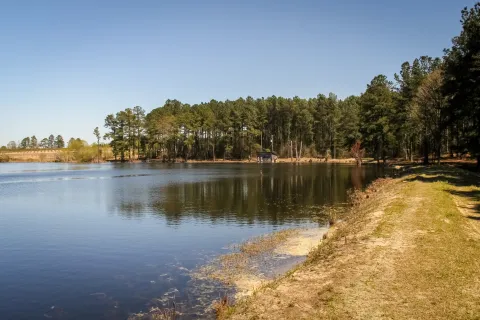SC Dam Safety Program
The in's and out's of the SC Dam Safety Program
Dam Safety Bill
Learn more about S. 107 and what it means for South Carolinians.
In South Carolina, there is an abundance of water, which means lots of dams, reservoirs and farm ponds exist throughout the state, from the upstate to the Lowcountry.
What does this have to do with agriculture?
Many farmers use ponds and reservoirs (created by dams) on their farms to store water for times of need. The water in these reservoirs not only helps crops, like the fruits and vegetables we love to eat, survive the hot, dry summer, but it also provides a habitat for wildlife all year long. Without these farm ponds, wildlife and crops would be under serious threat.
The Dam Safety Program Bill allows these farm ponds and dams to continue to exist, while also focusing state resources on high-hazard dams that pose the most risk.
S. 107 addresses concerns raised by community members and provides a source to fund the financial burden placed upon all dam owners following the reclassification of dams through a refundable tax credit.
According to the SC Department of Health and Environmental Control
The program has been successful since increasing funding and staffing following the 2015 flood, which has provided more tools benefitting program staff, owners and emergency responders. These additional resources have allowed for the assessment of all dams in the state. These assessments will help ensure that focus is placed on those dams that pose the most risk.
DHEC has been able to provide dam owner education, pre-storm notification and a focus on dams of high concern, leading to the continued success of the program and safety of South Carolina’s dam infrastructure.
But, there are continued challenges facing the Dam Safety Program, and S. 107 seeks to address these concerns.

Challenge
Maintain owner database
SOLUTION
S. 107 requires that a dam owner must provide their name, contact information and address to DHEC and that any changes must be reported to DHEC within 30 days.

Challenge
Accountability for repair
SOLUTION
S. 107 requires a dam owner of a high-hazard dam to provide DHEC a dam owner checklist, annually; an owner of a significant-hazard dam (one category lower) will need to provide the checklist to DHEC every five years. This checklist helps dam owners maintain their dam in good repair and to stay aware of any issues that may be occurring with the dam.
Learn more
Get involved

Benefits of S. 107
S. 107 is commonsense legislation that will keep us safe. Click here to learn more.
Learn more
Dam Safety at Work
The dam safety program is working. Click here to see how.
See the program in action
Speak Up
Contact your legislators and tell them a vote for S. 107 is a vote for South Carolina farmers.
Engage with your legislator